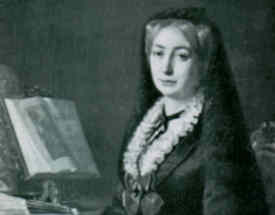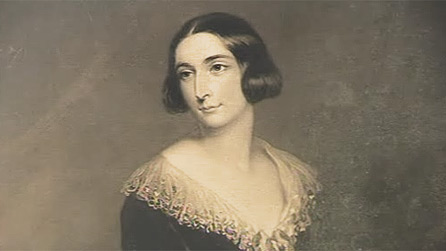Lady Charlotte Guest

Lady Charlotte Guest was born in 1812 and christened Lady Charlotte Elizabeth Bertie. Her father, Albermarle Bertie, was the ninth Earl of Lindsey, who died when she was six. A lonely child with a passion for literature, she was educated by tutors and realised by the age of sixteen that her interests were not those of most young women of her age. She became entranced by medieval history and legends, read widely on Oriental subjects and chose to learn the Persian language. At the age of twenty one, she moved to London and was soon to meet her future husband, the widower Josiah John Guest (later Sir Josiah John Guest). Guest had come to London from Merthyr Tydfil as the town's first member of parliament. He was a wealthy ironmaster from Wales and the couple perhaps shared a sense that they were outsiders and observers of the London social scene at the time. They married in 1833 and thus formed a partnership of the upper and the trade class, which was deemed scandalous by London's elite, who felt that Charlotte would now be living below her station. The couple went to live in the mansion pictured above, close to the Dowlais Iron Company which was soon to become the largest ironworks in the world.
Charlotte took an active interest in the ironworks, acting as a company accountant, and became involved in practical work for the employees and local people. She set out to help modernise schools and to promote adult education. She visited schools regularly, introduced new teaching methods and sometimes taught. The Guest schools have been called "the most progressive in the industrial history not only of South Wales, but of the whole of Britain during the nineteenth century". Whilst taking an active interest in politics, social issues, London society and the day to day management of the ironworks, Charlotte managed to learn Welsh and somehow found time to have children. She ultimately became the mother of ten children, a family size that was not unusual for the time. In 1846, the couple bought the large Canford Estate in Dorset and set about building a gothic mansion.
Charlotte's long standing interest in medieval literature combined with her love of her husband's country at a time when there was a widespread public interest in nationality, history and the tales of the past. The Guests were founder members of the Society of Welsh Scholars of Abergavenny together with Augusta Hall (better known as Lady Llanover). The Romantic revival of the time portrayed the glories of medieval life and led to a new interest in Celtic history.
In her translation of the Mabinogion tales Charlotte seems to have been
determined to produce a work of the highest quality and her editions remained the standard for over ninety years. The first
volume was published in 1838 and by 1845 the tales had appeared in seven parts. In her 1877 edition Charlotte drew attention
to the fact that Tennyson had based his Geraint and Enid (in The Idylls of the King) on her translation of one of the Mabinogion tales. The Idylls of the King became the most popular poetic work of the Victorian period, and time was to show that Charlotte succeeded in her wish to bring medieval Welsh literature to the attention of a wider public. In their 1948 translation, Gwyn and Thomas Jones paid tribute to her splendid achievement.

In 1852 John Guest died and Lady Charlotte took over at the helm of the Dowlais Iron Works. These days it is difficult to imagine the challenge this must have presented. Charlotte was forty years old when she took charge of this "vast industrial concern" engaged in supplying rails for the world's railways. Although trading conditions were difficult at this time, she obviously succeeded in the job, since the business ultimately flourished again. While maintaining the financial integrity of Dowlais, Lady Charlotte became an advocate for workers who chose not to work on Sunday, supported banning the practice of hiring young women and girls to pile iron at night, advocated an end to distributing pay in public houses, and established a set rate of pay in local industry to prevent further emigration to Australia.
By 1855 she had fallen in love with and married her son Ivor's tutor, a young Cambridge academic called Charles Schreiber. Now, the running of the ironworks was left to others as together they determined to assemble a ceramics collection. They travelled widely and bought furiously. The English section of the collection is now known as the Schreiber Collection and can be seen at the Victoria and Albert Museum in London. Charlotte became a great authority in this field and an expert on marks and forgeries.
Charles Schreiber died in 1884. Charlotte was now seventy-two years old but she continued to work on cataloguing their collection. In 1885, the collection was made available for public viewing and the Museum was presented with fifty copies of the catalogue. The collection and the catalogue proved valuable to generations of collectors and historians. In 1887, Charlotte worked with Augustus Franks of the British museum to produce a book on fans. From the late 1870's, she had been buying fans as collector's pieces, one of the first to take up this speciality. The book on English fans appeared in 1888 and was followed in 1890 by a volume on European fans. In 1891, the London Fan Makers awarded Charlotte the Freedom of their Company. She became, with Baroness Coutts, one of the only two "Freewomen" of Victorian England. Her fans were presented to the British Museum in 1891.
She died in 1895 having spent the last few years of her life campaigning for causes as diverse as Turkish refugees and
London cabmen. Charlotte was blessed with two happy marriages and led a life crowned with success in many fields. She will long
be remembered in Wales and by the international community of those with an interest in medieval studies.